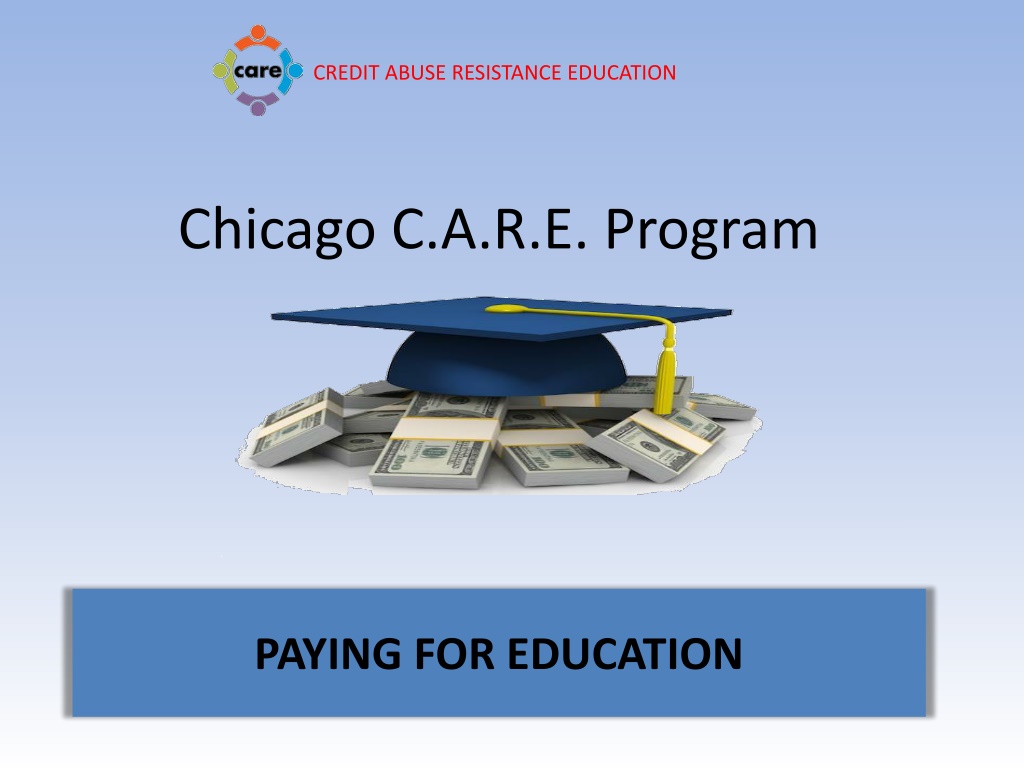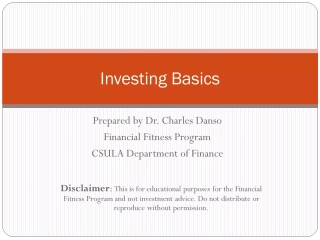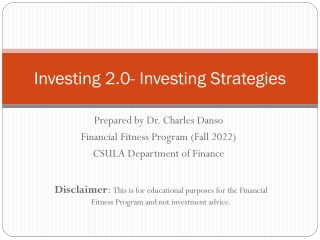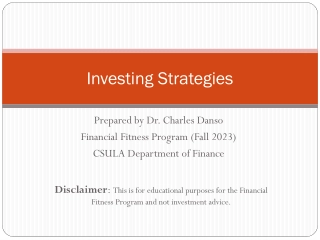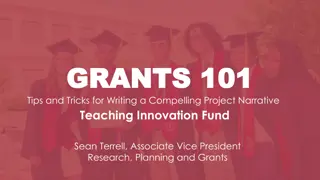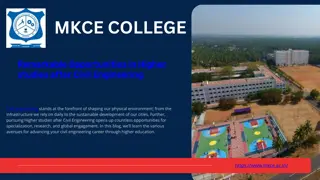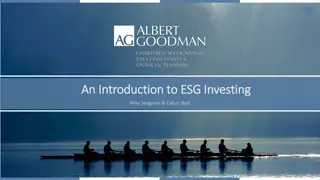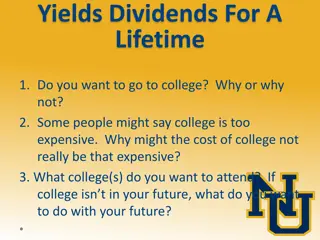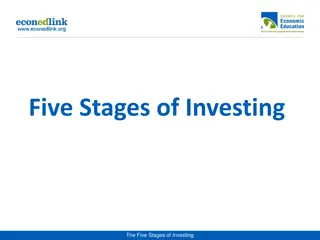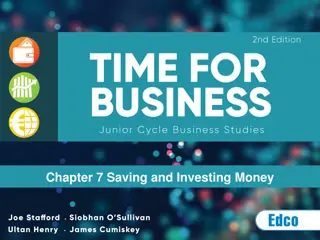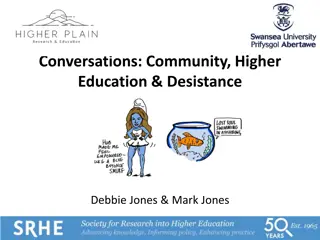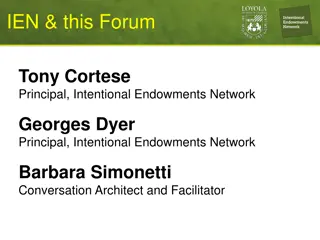Investing in Higher Education: Challenges and Opportunities
Explore the importance of planning for education costs, career opportunities, and sources of funding beyond student loans. Learn about different types of institutions and programs, average education costs, and various ways people finance their post-high school education. Consider the long-term benefits of investing in yourself through education.
Download Presentation

Please find below an Image/Link to download the presentation.
The content on the website is provided AS IS for your information and personal use only. It may not be sold, licensed, or shared on other websites without obtaining consent from the author. Download presentation by click this link. If you encounter any issues during the download, it is possible that the publisher has removed the file from their server.
E N D
Presentation Transcript
CREDIT ABUSE RESISTANCE EDUCATION Chicago C.A.R.E. Program PAYING FOR EDUCATION
Picture Yourself in 10 years What do you see yourself doing? (provide ideas via chat or in person) What does it take to get there? (list careers and how to achieve education, training, money, etc.) Many individuals who struggle with student debt do so because they did not carefully think through their educational goals or how to pay for them. 2
Higher Education is an Investment In Yourself It takes time, money and effort It can result in: Higher future income Better career and job opportunities Improved knowledge and abilities Heathier lifestyle Increased civic involvement Like any investment, it also has: Risks Costs Consider and weigh it all before you enroll! 3
Different Types of Institutions and Programs Public Universities (in state and out of state) Private Universities and Colleges Community/Junior Colleges Vocational and Technical Training Programs Apprenticeships Private For-Profit Programs 4
Education Is Not Cheap Average Cost in 2022-2023 was: Public (2 Year school) tuition, expenses, R&B* $19,230 Public tuition, expenses, R&B* (in state) Public tuition, expenses, R&B* (out of state) $45,240 Private tuition, expenses, R&B* $27,940 $57,570 *R&B average $9,610 for 2-year school, $12,310 for public 4- year school and $14,030 for private 4- year school. Source: College Board, Trends in College Pricing and Student Aid 2022 5
Other than student loans, how do people pay for post high school education? Try to answer this question before we go to the next slide 6
Sources for financing education 2% Grants & Scholarships 8% Family Income & Savings 29% 10% Loans to Students Student Income & Savings 11% Loans to Family Friends & Relatives 40% 7
Lets Start with Grants & Scholarships Why are Grants & Scholarships so great? (See if you can answer this question in chat or live) 8
GRANTS AND SCHOLARSHIPS ARE FREE MONEY Average amount of undergraduate grants and scholarships: $13,756 On average, grants and scholarships cover over 1/3 of costs Available for Trade schools 9
Primary Federal Grants are Pell Grants capped at $7,395/student/year (2023-24) do not need to be paid back need-based 10
Primary Illinois Grants Are Illinois Monetary Award Program (MAP) Illinois resident who attends an Illinois approved educational institution need-based financial aid awarded on a first-come, first-served basis to about 140,000 students a year. Up to $8,400 a year for tuition and mandatory fees paid directly to school 11
Scholarships Money that does not have to be paid back! Awarded on the basis of merit, skill, need or unique characteristics Do not pay for help to find scholarships it s usually a scam 12
Places to look for Scholarships -- High School Counselor Your Community Local Businesses, Community Clubs, Workplace or Professional Affiliations The educational institution you plan to attend On the Internet fastweb.com collegeanswer.com collegeboard.com Studentscholarshipsearch.com gocollege.com Finaid.org scholarshiphelp.org careerinfonet.org/scholarshipsearch Collegegreenlight.com man chasing money 13
Scholarships for Everyone Beans For Brains Scholarship (5 -$2,500) proficient knitters or crocheters. Fifth Month Scholarship ($1,500) you must write a letter to the number five (#5) and explain why the number five is so important. Zombie Apocalypse Scholarship ($2,000) Imagine zombies have taken over your school Write an essay on how will you survive. Two Ten Foundation Footwear Design Scholarship ($1,000 -$5,000) is available to any student who is studying design with a focus on footwear American Association of Candy Technologists ($2,500) majoring in food science Create-A-Greeting-Card $10,000 Scholarship Contest The Asparagus Club Scholarship ($2,000) for those pursuing a degree in business, food management or grocery industry. The American Fire Sprinkler Association (5 -$1,000). Read a short essay about sprinklers and fire safety and take a 10-question quiz (each correct answer gives you a chance to win). Vegetarian Resource Group ($5,000) show you promote a peaceful world through a vegetarian diet/lifestyle 14
Student Employment Get work-study financial aid in school Based on need on-campus job 10 15 hours per week and paid directly to student Get a job! Learn about your industry and network for future employment Apprenticeships (www.apprenticeship.gov) Paid Job Work based leaning Classroom learning - Mentorships - Credentials 15
Student Loans Student Loans should be your last source for funding. Why? (Try to answer in chat or live) 16
Student loans Student loans should be your last source of funding. Because student loans are DEBT. 17
Student loan debt The average student loan debt owed at graduation from a four-year college is $29,100 18
Many Students With Loans Dont Know: The interest rate on their loans Repayment terms Differences between federal and private loans The other significant options for financing their education that are NOT loans 19
Our 3 messages about borrowing for education 1. Student loans should be your last financing option Student loans are debt Only use student loans when all other sources are exhausted 2. Do not borrow more than you can afford 3. Be smart about the type of student loan you get Federal vs Private 20
Lets Review what we have learned so far by playing Kahoot www.Kahoot.it (we will have a game designed for this presentation and this will be the recommended first of two breaks for playing the game.) 21
Each year, the federal government awards roughly $ 242 billion to students through grants, loans, work-study and other aid. How do you access this money? 22
FAFSA Free Application For Federal Student Aid (FAFSA.GOV) Grants and loans for most educational programs require you to fill out a FAFSA FAFSA forms can be submitted starting October 1 of your senior year in high school Fill them our early. Money can run out Fill out FAFSA on-line by first setting up an account. You will need bank account information and tax returns. You must fill out a FAFSA each year you are in school that you wish to apply for financial aid. 23
How will you know what financial aid you are awarded? In the spring of your senior year, you will receive a financial aid letter from each educational institution that accepted you. The letter will tell you: grants you will receive. If you will get work-study funding. If you applied for a scholarship from the educational institution, it will tell you if you will receive it. Federal loans you are eligible to receive. 24
If you dont understand the letter, call the financial aid office! Ask questions. For example, will the financial aid award be given every year or do you have to re-apply? Advocate for yourself. If you need more money, ask for it. Make sure you understand what is free money and what money has to be repaid. 26
How much student loan debt can you afford? Rule of thumb: Your total student loan debt should not exceed your first-year salary after completion of your education A search of the internet will show you how much entry level salaries are in any profession in any location. This Photo by Unknown Author is licensed under CC BY-SA 27
Starting Salary/Manageable Student Debt Occupation High School Diploma Retail Secretary Home Health Aid Associate /Trade School/Apprenticeship Administrative Assistant Plumber Truck Driver Electrician Medical Technician Bachelor s Degree Teacher Registered Nurse Law Enforcement Accountant Nuclear Engineer Software Developer/Engineer Professional Degree Dentist Veterinarian $30,000 $31,600 $24,150 $34,625 $37,015 $38,275 $51,400 $54,675 $45,350 $63,175 $60,200 $60,550 $60,550 $88,850 $100,875 $74,525 28
Once you have a handle on the amount of student debt you can afford Ask yourself, will my target school require loans in excess of what I can afford? If yes, then STOP and re-think about going to this school. If you can afford to borrow, what kinds of choices do you have in student loans? 29
2 types of student loans not all student loan debt is created equal Federal Private 30
3 Types of Federal Loans Stafford Subsidized Stafford Unsubsidized PLUS Loans (Parent Loans for Undergraduate Students) 31
Federal Loans are not just for 4 Year Colleges Federal Student Loans are also available for: accredited trade schools Courses you need to enter a degree program Courses you need to get certified (or recertified) as a teacher Certification program that is training you for a specific career But, if your program does not end in a degree, you might not have access to federal student loans! 32
Federal Subsidized Stafford Loans Need-Based Your school determines the amount you can borrow Federal government pays interest while in school and for 6 months after you leave school Requires that you start paying the loan back 6 months after graduation 33
Federal Unsubsidized Stafford Loans NOT NEED BASED You owe interest from day one. You may pay the interest while in school or defer it. If you defer your interest, it will accrue (accumulate) and be capitalized (be added to the principal amount of your loan). Requires you start paying the loan back 6 months after graduation
PLUS LOANS (highlights) Need based Parents can borrow up to cost of attendance minus any other financial aid award amounts Parents must have excellent credit history Also available to graduate students 35
1. Fixed interest rates Interest rate 9.00% 8.00% 7.00% 6.00% 5.00% Interest rate 8.05% 4.00% 5.50% 5.50% 3.00% 2.00% 1.00% 0.00% Stafford subsidized Stafford unsubsidized PLUS All interest rates are fixed rates for the life of the loan. Interest rates are reset each year but once you take out a loan the interest rate is fixed for that particular loan. 37
2. Cap on amounts Yearly caps $5,500 to $12,500 Cap on total amount borrowed 3. Interest deferral which in school 4. Long cure (grace) period 270 days 38
5. Friendly Repayment Options Fixed payments over 10 year period. That is 120 monthly payments. Other options: Extended Plan - extends repayment period with lower monthly payments Pay as you earn pay only 10% of your income Graduated Plan payments are lower at first and then increase usually every 2 years 39
Loan Forgiveness Programs Teacher Loan Forgiveness: Teaching full-time in a low-income elementary or secondary school for five consecutive years Public Service Forgiveness employed full-time (30+ hours/week) in a public service job, such as police, fire, military and charities forgives the remaining balance on your direct loans after you have made 120 on-time monthly payments 40
What is a private loan? Arranged privately with your bank or other financial institution Approximately 2.9 million students currently have private loans Total Private loans outstanding is $146.9 billion (approximately 8.3% of total student debt). Discover Student Loans Logo Graduate Leverage 41
Private loan features Responsible adult co-signs Floating interest rates depends on credit history can go as high as 25%-30% Immediate payment (not deferred) No right to postpone or extend payments Hair trigger defaults 42
Heres the bottom line on private student loans Get them only after you have exhausted all other options for financing 43
Defaults Yes, it can happen to you It was estimated before the Covid-19 pandemic that a quarter of student loan borrowers were either delinquent or in default on more than $175 billion in federal student debt* Approximately 10.8% of borrowers were in default on federal student loans within 2 years of having to make payments * Based on U.S. Department of Education, Federal Student Loan Portfolio: Direct Loan and Federal Family Education Loan Portfolio by Loan Status (2019) 44
WHAT HAPPENS IF YOU DEFAULT? (for both Federal and Private loans) Student loans must be repaid whether or not the student finishes his/her program of study Lender can sue you Lender can garnish (take a percentage of) wages and (once received) social security benefits Income tax refunds may be intercepted Can t renew professional licenses It s on your credit report, with disastrous effects for getting credit cards, auto loans, rental apartment, even a job 45
I Can Always File Bankruptcy To Get Out Of My Student Loan - Can t I? No it is very difficult to discharge student loans in bankruptcy. Only one percent of student loan debt gets discharged. 46
Lets review what we learned about loans with more Kahoot www.kahoot.it (finish the game you started after slide 21) 47
Summarize 1. Look for education funding from sources other than student loans Fill out FAFSA early Apply for grants and scholarships early and widely Talk to financial aid officers 2. Figure out how much in student loans you can afford Does your desired career provide the earning power to pay off your loans? 48
Summarize 3. If you need loans, get federal loans first, private loans last 4. Borrow only what you need 5. DO NOT miss a payment. Default is very expensive 49
